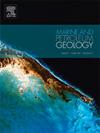冲绳海槽不同的AOM作用驱动碳酸盐岩结壳和结核的形成
IF 3.6
2区 地球科学
Q1 GEOSCIENCES, MULTIDISCIPLINARY
引用次数: 0
摘要
甲烷厌氧氧化(AOM)是消耗海洋沉积物中形成的甲烷并诱导冷渗碳酸盐沉淀的关键过程。然而,在不同类型碳酸盐的形成过程中,硫酸盐驱动AOM (SD-AOM)和铁驱动AOM (Fe-AOM)的影响因素尚不清楚。本文对冲绳海槽北部的冷渗碳酸盐岩结壳和结核进行了矿物学和地球化学研究。碳酸盐结壳表面粗糙,结构松散,而碳酸盐结核表面致密,结构均匀。地壳样品中的碳酸盐矿物主要为文石,而结核样品中的碳酸盐矿物主要为方解石和白云石,以及方解石和文石。所有样品的δ13C值均为负,表明碳主要来源于生物甲烷。δ18O富集表明,参与自生碳酸盐岩形成的流体可能来自天然气水合物的解离作用。矿物学和稀土元素(REE)特征表明,在高甲烷通量条件下,碳酸盐岩结壳形成于靠近海底的位置,而在低甲烷通量条件下,碳酸盐岩结核在较深的位置发育。文石为主,δ18OCAS/δ34SCAS坡度低(碳酸盐岩伴生硫酸盐,CAS),表明SD-AOM驱动了碳酸盐岩结壳的沉淀。相比之下,白云石和菱铁矿的存在、富铁微生物结构以及碳酸盐相关铁的升高水平共同支持了碳酸盐结核形成过程中铁- aom的贡献。研究表明,碳酸盐岩结壳和结核的不同形成条件决定了它们的不同AOM过程。本文章由计算机程序翻译,如有差异,请以英文原文为准。

Different AOM processes driving the formation of carbonate crusts and nodules in the Okinawa Trough
Anaerobic oxidation of methane (AOM) serves as a critical process that consumes methane formed in marine sediments and induces the precipitation of cold seep carbonates. However, the factors influencing sulfate-driven AOM (SD-AOM) and iron-driven AOM (Fe-AOM) during the formation of different types of carbonates remain unclear. In this study, mineralogical and geochemical studies were conducted on cold seep carbonate crusts and nodules in the northern Okinawa Trough (OT). Carbonate crusts exhibit rough surfaces with loose textures, while carbonate nodules are characterized by dense and homogeneous textures. The carbonate minerals in the crust samples are predominantly aragonite, whereas the primary carbonate minerals in the nodule samples are calcite and dolomite, as well as calcite and aragonite. The negative δ13C values of all samples indicate that the carbon is mainly sourced from biogenic methane. The δ18O enrichment suggests that the fluid involved in authigenic carbonate formation could be derived from the dissociation of natural gas hydrates. Mineralogical and rare earth element (REE) features reveal that carbonate crusts formed close to the seafloor under high methane fluxes, whereas carbonate nodules developed at greater depths under lower methane fluxes. The predominance of aragonite and low δ18OCAS/δ34SCAS slope (carbonate-associated sulfate, CAS) indicate that SD-AOM drove the precipitation of carbonate crusts. In contrast, the presence of dolomite and siderite, iron-rich microbial structures, and elevated levels of carbonate-associated Fe collectively support the contribution of Fe-AOM during the formation of carbonate nodules. Our study highlights that the distinct formation conditions of carbonate crusts and nodules govern their differential AOM processes.
求助全文
通过发布文献求助,成功后即可免费获取论文全文。
去求助
来源期刊

Marine and Petroleum Geology
地学-地球科学综合
CiteScore
8.80
自引率
14.30%
发文量
475
审稿时长
63 days
期刊介绍:
Marine and Petroleum Geology is the pre-eminent international forum for the exchange of multidisciplinary concepts, interpretations and techniques for all concerned with marine and petroleum geology in industry, government and academia. Rapid bimonthly publication allows early communications of papers or short communications to the geoscience community.
Marine and Petroleum Geology is essential reading for geologists, geophysicists and explorationists in industry, government and academia working in the following areas: marine geology; basin analysis and evaluation; organic geochemistry; reserve/resource estimation; seismic stratigraphy; thermal models of basic evolution; sedimentary geology; continental margins; geophysical interpretation; structural geology/tectonics; formation evaluation techniques; well logging.
 求助内容:
求助内容: 应助结果提醒方式:
应助结果提醒方式:


